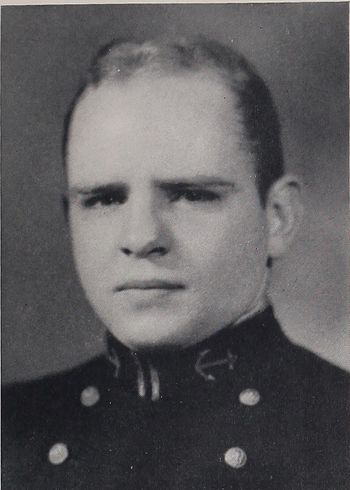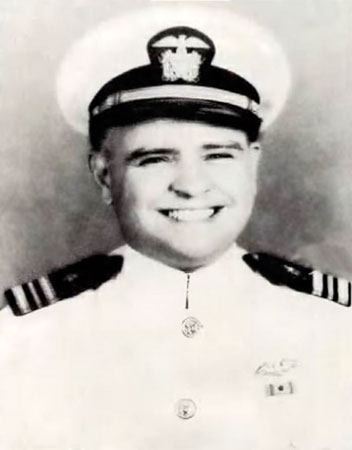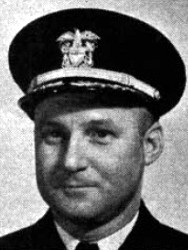JOHN A. MOORE, CDR, USN
John Moore '32
Lucky Bag
From the 1932 Lucky Bag:
JOHN ANDERSON MOORE
Bisbee, Arizona
"Johnnie"
Johnnie left Arizona and came to the U. S. N. A. more out of curiosity than anything else. When a boy he had heard about water but things have to be proven to Johnny. Johnny is a great little man. Wherever Johnny is there will be something going on. He is never lacking in enthusiasm, energy, or ideas. If nothing else presents itself a rough house or so is always good.
Johnny is not exactly savvy, but he has seldom been below section five or six. He has had his little tussles with the English Department, but he got that 2.5 the same way he has won everything else he has undertaken. Johnny is a little scrapper. Of sports, he likes boxing best and woe unto the man that gets in front of his right hand in a pugilistic way.
Johnny is a real friend. He is the kind a man likes to have along when anticipating a scrap—a true friend through and through. With his pleasing personality and ability to make friends, Johnny is sure to go far. He is the kind that is sure to succeed in the Service or in any branch of endeavor on the outside. Our best wishes travel with him, always.
Soccer; Boxing, BNAT; 2 P. O.

JOHN ANDERSON MOORE
Bisbee, Arizona
"Johnnie"
Johnnie left Arizona and came to the U. S. N. A. more out of curiosity than anything else. When a boy he had heard about water but things have to be proven to Johnny. Johnny is a great little man. Wherever Johnny is there will be something going on. He is never lacking in enthusiasm, energy, or ideas. If nothing else presents itself a rough house or so is always good.
Johnny is not exactly savvy, but he has seldom been below section five or six. He has had his little tussles with the English Department, but he got that 2.5 the same way he has won everything else he has undertaken. Johnny is a little scrapper. Of sports, he likes boxing best and woe unto the man that gets in front of his right hand in a pugilistic way.
Johnny is a real friend. He is the kind a man likes to have along when anticipating a scrap—a true friend through and through. With his pleasing personality and ability to make friends, Johnny is sure to go far. He is the kind that is sure to succeed in the Service or in any branch of endeavor on the outside. Our best wishes travel with him, always.
Soccer; Boxing, BNAT; 2 P. O.
Loss
John was lost when USS Grayback (SS 208) was sunk by Japanese aircraft on February 26, 1944 south of Okinawa.
Other Information
His wife, Virginia May Shaw, was listed as next of kin — they were married in San Pedro, California, on December 19, 1932. They had a daughter, Shawla Ann, born March 3, 1934 in Los Angeles. He was also survived by his mother and three siblings.
Photographs
From Hall of Valor:
The President of the United States of America takes pleasure in presenting the Navy Cross to Commander John Anderson Moore (ASN: 071323), United States Navy, for extraordinary heroism in the line of his profession as Commanding Officer of the U.S.S. GRAYBACK (SS-208), on the EGHTH War Patrol of that submarine during the period 26 September 1943 to 10 November 1943, in enemy controlled waters of the East China Sea. During this aggressive patrol, Commander Moore made five separate well-planned and brilliantly executed torpedo attacks on escorted enemy ships which resulted in the sinking of an auxiliary cruiser and two freighters. Through his experience and sound judgment he brought his ship safely back to port. His conduct throughout was an inspiration to his officers and men and in keeping with the highest traditions of the United States Naval Service.
General Orders: Bureau of Naval Personnel Information Bulletin No. 329 (August 1944)
Action Date: September 26 - November 10, 1943
Service: Navy
Rank: Commander
Company: Commanding Officer
Division: U.S.S. Grayback (SS-208)
From Hall of Valor:
The President of the United States of America takes pleasure in presenting a Gold Star in lieu of a Second Award of the Navy Cross to Commander John Anderson Moore, United States Navy, for extraordinary heroism in the line of his profession as Commanding Officer of the U.S.S. GRAYBACK (SS-208), on the NINTH War Patrol of that submarine during the period 2 December 1943 to 2 January 1944, in enemy controlled waters of the East China Sea. On the night of 18 - 19 December 1943, Commander Moore contacted a heavily escorted convoy of Japanese freighters. Maneuvering on the surface, he fired into the convoy, sinking one freighter, damaging two others and sinking a gunboat. On the same patrol he contacted another escorted convoy at night and sank three enemy freighters. He followed up with another attack and sank a converted minelayer, then destroyed an armed trawler while departing from the area. Through his experience and sound judgment Commander Moore brought his ship safely back to port. His conduct throughout was an inspiration to his officers and men and in keeping with the highest traditions of the United States Naval Service.
General Orders: Bureau of Naval Personnel Information Bulletin No. 330 (September 1944)
Action Date: December 2, 1943 - January 4, 1944
Service: Navy
Rank: Commander
Company: Commanding Officer
Division: U.S.S. Grayback (SS-208)
From Hall of Valor:
The President of the United States of America takes pride in presenting a Second Gold Star in lieu of a Third Award of the Navy Cross (Posthumously) to Commander John Anderson Moore (ASN: 071323), United States Navy, for extraordinary heroism in the line of his profession as Commanding Officer of the U.S.S. GRAYBACK (SS-208), on the TENTH War Patrol of that submarine during the period 26 January 1944 to 26 February 1944, in enemy controlled waters of the East China Sea. While conducting the patrol of his ship in Japanese-infested waters, Commander Moore skillfully penetrated strong escort screens to deliver smashing torpedo attacks against hostile shipping. By his daring, aggressive tactics he succeeded in sinking and damaging an important amount of hostile tonnage. The conduct of Commander Moore throughout this patrol reflects great credit upon himself, and was in keeping with the highest traditions of the United States Naval Service. He gallantly gave his life for his country.
General Orders: Bureau of Naval Personnel Information Bulletin No. 336 (March 1945)
Action Date: January 26 - February 26, 1944
Service: Navy
Rank: Commander
Company: Commanding Officer
Division: U.S.S. Grayback (SS-208)
Career
From the now-broken link http://www.fleetorganization.com/subcommandersclassyear3.html:
- Under Instruction Post Graduate School United States Naval Academy 1939
- Duty USS Sands (DD-243) 1 Oct 1939 - 1 Jul 1940
- Duty Detail Section Officer Personnel Division Bureau of Navigation 1 Nov 1940
- Captain USS Grayback (SS-208) 19 Jul 1943 - Feb 1944
- Lieutenant (j.g.) 2 Jun 1935
- Lieutenant 1 May 1940
- Lieutenant Commander (T) 15 Jun 1942
- Commander (T) 18 Nov 1942
Wartime Service
From Naval History and Heritage Commmand:
Eighth Patrol
Arriving Pearl Harbor on 12 September 1943, Grayback prepared for her eighth war patrol, now under the command of John Anderson Moore. Sailing 26 September with Shad (SS-235), she rendezvoused with Cero (SS-225) at Midway Island to form the first of the Submarine Force's highly successful wolfpacks. The three submarines under Captain "Swede" Momsen in Cero, cruised the China Sea and returned to base with claims of 38,000 tons sunk and 3300 damaged. Grayback accounted for two ships, a passenger-cargo vessel torpedoed 14 October and a former light cruiser, Awata Maru, torpedoed after an end-around run on a fast convoy 22 October. Wolf pack tactics came into play 2 October as Grayback closed a convoy already attacked by Shad and sunk a 9000-ton transport listing from two of Shad's torpedoes. The submarines had now expended all torpedoes, and on 10 November they returned to Midway.Grayback CO, John Anderson Moore was awarded after this mission a Navy Cross (see Bureau of Naval Personnel Information Bulletin No. 329 (August 1944))
Ninth patrol
With almost a quarter of her crew untested in battle Grayback departed Pearl Harbor for the East China Sea on 2 December for her ninth war patrol. Within five days of her first contact with Japanese ships, she had expended all her torpedoes in a series of attacks which netted four ships for a total of over 10,000 tons. On the night of 18 to 19 December Grayback attacked convoy of four freighters and three escorts. She sent freighter Gyokurei Maru and escort Numakaze to the bottom and damaged several others in surface attack. Two nights later, 20 to 21 December, she spotted another convoy of six ships; and, after an end-around run she fired a spread of nine torpedoes into the heart of the Japanese formation. This first attack sunk one freighter and damaged another before Grayback dived to elude depth charges. Three hours later she surfaced and sank a second freighter. After an unsuccessful attack the following night had exhausted her torpedo supply, Grayback headed home. The submarine surfaced 27 December and sank a good-sized fishing boat with deck guns before reaching Pearl Harbor on 4 January 1944.Grayback's CO, John Anderson Moore was awarded after this mission by second Navy Cross (see Bureau of Naval Personnel Information Bulletin No. 330 (September 1944))
Tenth Patrol
Grayback's tenth patrol, her most successful in terms of tonnage sunk, was also to be her last. She sailed from Pearl Harbor on 28 January 1944, for the East China Sea. On 24 February Grayback radioed that she had sunk two cargo ships 19 February and had damaged two others (Taikei Maru and Toshin Maru sunk). On 25 February she transmitted her second and final report. That morning she had sunk tanker Nanho Maru and severely damaged Asama Maru. With only two torpedoes remaining, she was ordered home from patrol. Due to reach Midway on 7 March, Grayback did not arrive. On 30 March ComSubPac listed her as missing and presumed lost with all hands.From captured Japanese records the submarine's last few days can be pieced together. Heading home through the East China Sea after attacking convoy Hi-40 on 24 February, Grayback used her last two torpedoes to sink the freighter Ceylon Maru on 27 February. That same day, a Japanese carrier-based plane spotted a submarine on the surface in the East China Sea and attacked. According to Japanese reports the submarine "exploded and sank immediately," but antisubmarine craft were called in to depth-charge the area, clearly marked by a trail of air bubbles, until at last a heavy oil slick swelled to the surface. Grayback had ended her last patrol, one which cost the enemy some 21,594 tons of shipping.
Grayback CO, John Anderson Moore was posthumously awarded after this mission by third Navy Cross (see Bureau of Naval Personnel Information Bulletin No. 336 (March 1945))
Grayback ranked 20th among all submarines in total tonnage sunk with 63,835 tons and 24th in number of ships sunk with 14. The submarine and crew had received two Navy Unit Commendations for their seventh, eighth, ninth, and tenth war patrols.
Namesake
USS John A. Moore (FFG 19) was named for John.
USS Grayback (SSG 574)
John's widow sponsored USS Grayback (SSG 574), launched in 1957.
Discovery of Grayback
In 2019 USS Grayback was found near Okinawa. Previous expeditions to locate her final resting place had been unsuccessful because of a mistake in translating the attacking aircraft's report.
Order in Class of 1932 Panel
It's unclear why John is listed chronologically by his presumed-dead date (date of loss + 1 year) instead of his actual loss date.
The "Register of Commissioned and Warrant Officers of the United States Navy and Marine Corps" was published annually from 1815 through at least the 1970s; it provided rank, command or station, and occasionally billet until the beginning of World War II when command/station was no longer included. Scanned copies were reviewed and data entered from the mid-1840s through 1922, when more-frequent Navy Directories were available.
The Navy Directory was a publication that provided information on the command, billet, and rank of every active and retired naval officer. Single editions have been found online from January 1915 and March 1918, and then from three to six editions per year from 1923 through 1940; the final edition is from April 1941.
The entries in both series of documents are sometimes cryptic and confusing. They are often inconsistent, even within an edition, with the name of commands; this is especially true for aviation squadrons in the 1920s and early 1930s.
Alumni listed at the same command may or may not have had significant interactions; they could have shared a stateroom or workspace, stood many hours of watch together, or, especially at the larger commands, they might not have known each other at all. The information provides the opportunity to draw connections that are otherwise invisible, though, and gives a fuller view of the professional experiences of these alumni in Memorial Hall.
October 1932
January 1933
April 1933
July 1933
October 1933
April 1934
July 1934
October 1934
January 1935
April 1935
October 1935
July 1936
April 1937
September 1937
January 1938
July 1938
January 1939
October 1939
June 1940
November 1940
April 1941

The "category" links below lead to lists of related Honorees; use them to explore further the service and sacrifice of alumni in Memorial Hall.

